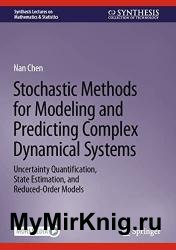 Название: Stochastic Methods for Modeling and Predicting Complex Dynamical Systems: Uncertainty Quantification, State Estimation, and Reduced-Order Models Название: Stochastic Methods for Modeling and Predicting Complex Dynamical Systems: Uncertainty Quantification, State Estimation, and Reduced-Order Models
Автор: Nan Chen
Издательство: Springer
Серия: Synthesis Lectures on Mathematics & Statistics
Год: 2023
Страниц: 208
Язык: английский
Формат: pdf (true), epub
Размер: 27.2 MB
This book enables readers to understand, model, and predict complex dynamical systems using new methods with stochastic tools. The author presents a unique combination of qualitative and quantitative modeling skills, novel efficient computational methods, rigorous mathematical theory, as well as physical intuitions and thinking. An emphasis is placed on the balance between computational efficiency and modeling accuracy, providing readers with ideas to build useful models in practice. Successful modeling of complex systems requires a comprehensive use of qualitative and quantitative modeling approaches, novel efficient computational methods, physical intuitions and thinking, as well as rigorous mathematical theories. As such, mathematical tools for understanding, modeling, and predicting complex dynamical systems using various suitable stochastic tools are presented. Both theoretical and numerical approaches are included, allowing readers to choose suitable methods in different practical situations. The author provides practical examples and motivations when introducing various mathematical and stochastic tools and merges mathematics, statistics, information theory, computational science, and Data Science. In addition, the author discusses how to choose and apply suitable mathematical tools to several disciplines including pure and applied mathematics, physics, engineering, neural science, material science, climate and atmosphere, ocean science, and many others. Readers will not only learn detailed techniques for stochastic modeling and prediction, but will develop their intuition as well. Important topics in modeling and prediction including extreme events, high-dimensional systems, and multiscale features are discussed.
Machine Learning has become a prevalent and powerful tool to advance the modeling and forecast of many complex dynamical systems. One of the main advantages of machine learning is its computational efficiency. In fact, once a Machine Learning model is trained, the forecast utilizing such a model is often much cheaper than numerically integrating a traditional high-dimensional nonlinear dynamical model made up of explicit parametric terms. Another merit of Machine Learning is that it typically involves sophisticated nonlinear structures, which after a suitable calibration, allow its forecast to capture more detailed features than the traditional knowledge-based dynamical models. The latter is often represented by certain parametric forms determined by human knowledge and may suffer from model error due to the lack of a complete understanding of nature. Therefore, Machine Learning has great potential to forecast extremely complicated, high-dimensional, and nonlinear systems. Despite these merits, several issues may exist in the Machine Learning forecast. First, the forecast skill of a Machine Learning model heavily relies on the quality of the training data. Unfortunately, there is a lack of adequate training data in many practical situations, and the training data may only be available for a subset of the state variables. For example, high-quality satellite data is available only for less than half of a century, which is far from sufficient for studying many decadal or even interannual variabilities in geophysics, climate, atmosphere, and ocean science. Second, due to the intrinsic complicated structures in many Machine Learning architectures, such as neural networks, Machine Learning may not be the most appropriate tool for understanding the underlying physics. But it is an essential tool for outcome-driven tasks such as forecasts and parameterizations.
One natural way to utilize stochastic models to assist Machine Learning in the presence of limited data is to apply these stochastic models to generate long time series that calibrate the parameters in the Machine Learning model. Then the available small amount of observational information is adopted to further tune the parameters via transfer learning. Bayesian neural network is another way to combine outputs from a certain knowledge-based stochastic model with observations that also includes uncertainty quantification
Contents:
1. Stochastic Toolkits
2. Introduction to Information Theory
3. Basic Stochastic Computational Methods
4. Simple Gaussian and Non-Gaussian SDEs
5. Data Assimilation
6. Prediction
7. Data-Driven Low-Order Stochastic Models
8. Conditional Gaussian Nonlinear Systems
9. Parameter Estimation with Uncertainty Quantification
10. Combining Stochastic Models with Machine Learning
11. Instruction Manual for the MATLAB Codes
Скачать Stochastic Methods for Modeling and Predicting Complex Dynamical Systems
|